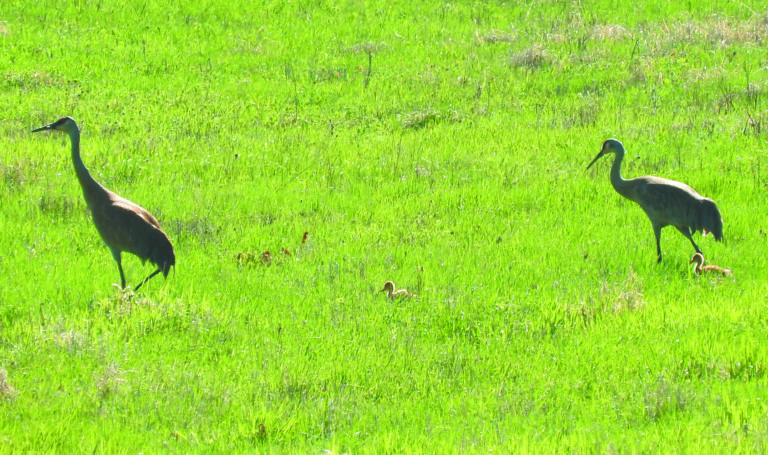
By Jan Axelson
Northside News
We are lucky to live in the heart of sandhill crane country. These elegant birds, standing 4 feet tall with wingspans of 6 feet, live and nest right here on the Northside. Toward the end of February, the cranes begin arriving from their wintering grounds to the south. You may hear their resounding, bugling calls before you spot any birds.
On arrival at their breeding grounds, sandhill cranes use their beaks to paint their feathers with mud, turning their bodies from gray to rusty brown. If you are lucky, you may see a pair of cranes dancing, flapping their wings, jumping, and tossing plants or sticks in the air. Due to the efforts of the International Crane Foundation (ICF), you may even spot a pure white whooping crane migrating through on its way to or from its breeding grounds to the north.
Cranes build their nests in wet, open areas. The female typically lays two eggs but has just one successful fledgling. The young, called colts, leave the nest within a day after hatching. They begin to fly after about two months but stay with their parents for almost a year. Cranes can live to be 20 years old or more and mate for life.
A crane’s diet varies with the season and can include grains, plant tubers, berries, mice, insects, snakes, worms and nesting birds. To keep cranes from pulling up corn seedlings, farmers plant corn treated with a substance that gives the planted kernels an unpleasant taste.
Sandhill cranes were not always a common sight. In the 1930s, the estimated population of nesting sandhill cranes in all of Wisconsin was just 25 pairs. Even into the 1970s and beyond, seeing a crane in Wisconsin was an infrequent treat. Thanks to reduced hunting (there is no hunting in Wisconsin) and the restoration of wetlands, the population is no longer considered at risk. Wisconsin has about 5,000 breeding pairs plus several thousand nonbreeding birds.
To keep tabs on crane numbers, the ICF has sponsored volunteer crane counts every April since 1976. This year, counters in three areas of Cherokee Marsh reported a total of 25 cranes.
We are fortunate to have many spots for viewing sandhill cranes in the wild. Cherokee Marsh Conservation Park’s North and South Units, Warner Park and Yahara Heights Park all host nesting cranes.
If you see a crane, give it space. If you’re close enough to cause the bird to change its behavior, you’re too close. Attracting cranes to neighborhoods with corn or other seed puts the birds at risk, including being hit by vehicles and poisoned by lawn chemicals. By keeping a safe distance and refraining from feeding the cranes, you help keep these special birds, which once were so uncommon, abundant, healthy and wild.